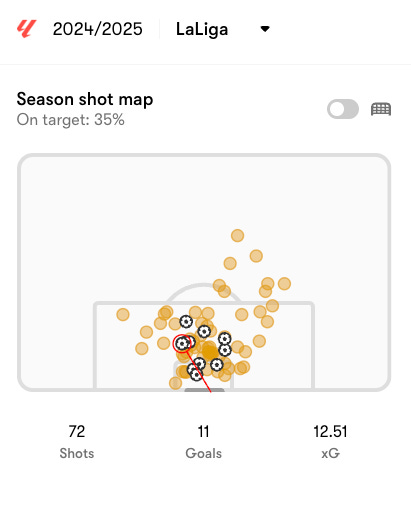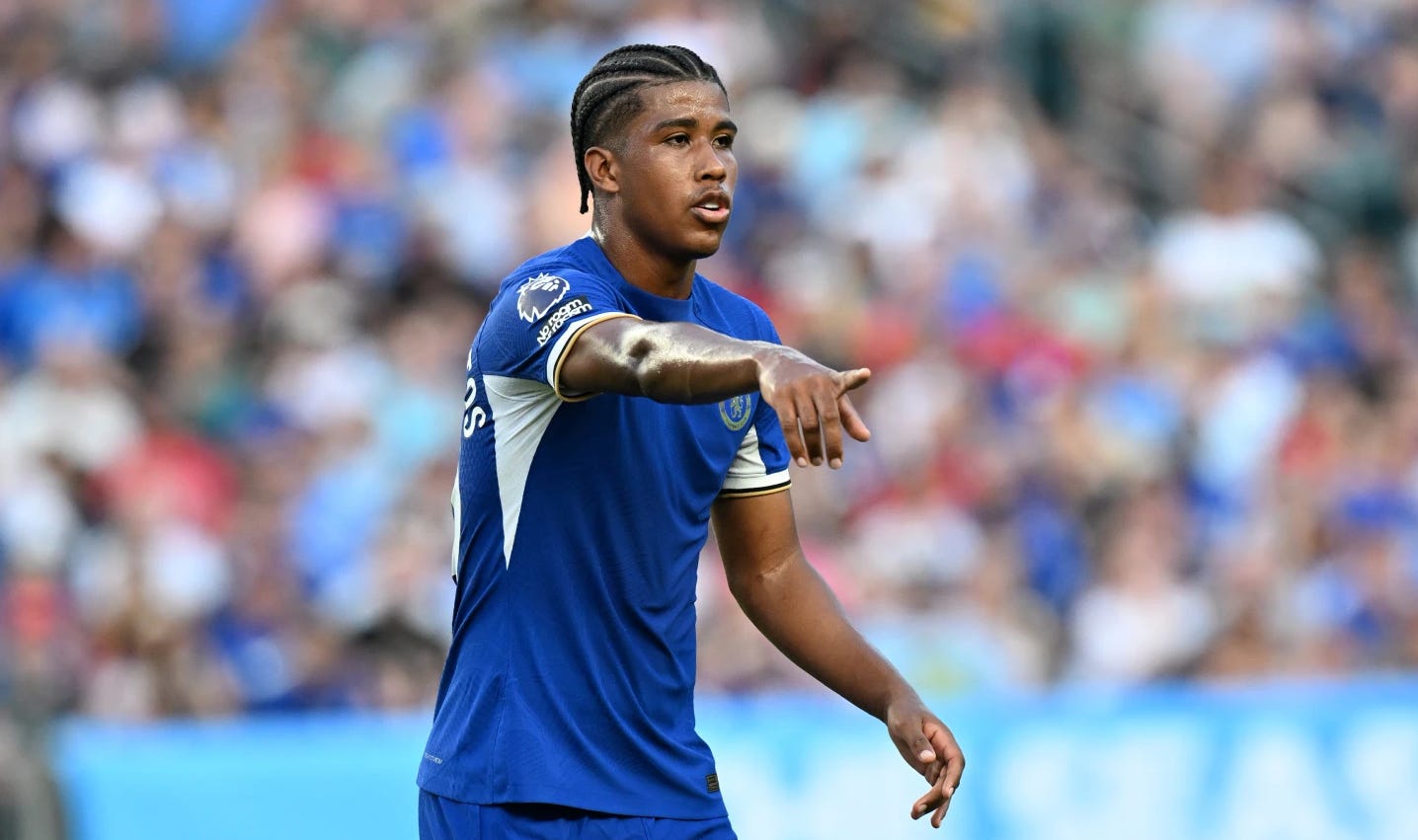Transfer dribble #2: Thierno Barry watch, Chelsea doing Chelsea things, and AI in FPL
Another batch of things I find interesting.
The pre-season format of this will be as free-flowing as peak Kevin De Bruyne, covering Premier League transfers, all sorts of FPL stuff, or weird things people say about football data. Once we enter the regular season, it will be more about actionable fantasy advice, which will help you better understand the data and make sounder managerial decisions. So, bear with me.
Thierno Barry at Everton: Is this a sensible transfer?
The big, big striker transfers are still to happen, with Viktor Gyökeres (Arsenal) and Hugo Ekitiké (Liverpool?) possibly joining the Premier League next season.
However, Everton’s signing of 22-year-old French international Thierno Barry is a breath of fresh air and a pretty good piece of business, if you ask me.
Not only in terms of transfer fee on a difficult market when it comes to strikers — reportedly €32 million (£27.6m) — but also in terms of quality.
Yes, Barry has only one season in the top 5 leagues under his belt. However, if you have a conviction, you need to pull the trigger.
Barry played 2,600 minutes last season at Villarreal and immediately ranked among the best number nines in La Liga—movement in the box, volume of shots, activity in the penalty area, receiving in good spaces, or carrying the ball. All of this at a high level.
What immediately strikes you is that he is a big guy. He stands 1.95 meters tall and offers a significant aerial threat. Data shows that he won a large number of aerial duels with a success rate in the 99th percentile.
And as you may know, since David Moyes arrived in Gameweek 21 last season, Everton have ranked 3rd best for xG generated from set-pieces, so I’m sure they will find a good use for him next season. It’s worth noting that Villarreal were one of the most dangerous teams from dead-ball situations last season.
Barry has averaged 2.40 shots and 0.39 xG per 90 minutes, so in terms of chance quality, he performed commendably.
Let’s dissect it some more. He totalled:
72 shots
12 xG
11 post-shot xG
11 goals (one from a penalty)
The shot map looks pretty good, with only 8 attempts from outside the box and most of the shots taken centrally. Regarding how he took them:
right foot: 35
head: 27
left foot: 8
Although he’s tall, he’s also quite mobile. You don’t often see a player of his physical build ranked in the 75th percentile in advanced metrics that measure the value of his running. He can carry the ball into good areas and draw fouls with his movement. A nice bonus is that he posted average xA numbers and recorded 4 assists during the season.
There is a certain former Villarreal striker who frustrated many in FPL, but it was hardly a flop from a more footballing perspective. And Barry certainly seems like a nice piece of scouting. His expected minutes will most likely not be secure at the start of the season, but he should gradually become a first-choice number nine during autumn. Let’s see if we can utilise him at some point.
Do Chelsea want to collect all the defensive midfielders in the world?
I am a fan of minimalism.
I hate to have my desk cluttered.
Or having useless stuff I don’t use.
Managing Chelsea’s squad would give me serious PTSD, with one position in particular catching my attention as a Spurs fan.
The way I see it, we are in dire need of a number six—like the sort of player Christian Nørgaard is. Or Moisés Caicedo, who was one of the most influential players last Premier League season.
His tackling skills reminded me of N’Golo Kanté in his prime, when he played more of a destroyer number 6 role, rather than a hybrid number 8 towards the end of his career.
The Colombian completed around 4 tackles with nearly an 80% success rate. Both figures are enormous, but having both of these stats that high is exceptional. His decision-making with the ball is truly outstanding, and you also have to consider the large number of intercepted and blocked passes.
And it goes without saying that he can recover so many balls in crucial areas and against dangerous attacks.
Roméo Lavia has had his share of injuries, but he also has great potential.
Then there are two new guys I would like to discuss.
Firstly, Andrey Santos. Like Lavia, he is still only 21 years old—and what a player he is!
Santos excelled on loan at Strasbourg last season and ranked among the most promising young players in Ligue 1.
Now, I mentioned that I would discuss number 6’s, and Santos played there just for about a third of the season, with tackling skills comparable to Caicedo’s. However, for most of the time, he leaned towards a more advanced, number-8ish role. He accumulated a solid amount of final passes, and 0.10 xA per 90.
Additionally, he scored 10 goals, averaging 1.30 shots and 0.15 xG per 90 minutes. He scored:
4 goals from open play (including two long-range efforts)
6 goals from set pieces (2 xG, 5 post-shot xG, quite a finishing)
It will be very difficult to replicate that under new conditions, but even without the final product, I rate that guy highly.
Then there’s Dário Essugo, a 20-year-old Portuguese midfielder from Las Palmas. He has played approximately 2,100 minutes for the team, which was relegated after finishing 19th in La Liga. Although it doesn’t sound very promising, Essugo was one of the few players who didn’t disappoint.
He ranked in the 75th percentile in advanced data metric, which assesses how effectively a player can disrupt dangerous attacks or win the ball in the defensive third. Additionally, he was outstanding at tackling and intercepting the ball overall—he consistently hovered around the 90th percentile in these areas.
You might vaguely remember that there is also Lesley Ugochukwu, YET ANOTHER 21-year-old defensive midfielder. If some media reports are correct, it appears his days are numbered. However, he’s a talented young player who, with the right development, could have a promising career. It will be interesting to revisit this article in five years.
Evaluating Chelsea transfers is fun, and I might write an article or thread about some of their other players (yes, you, Jamie Gittens). For FPL purposes, though, it will be tricky, or rather borderline painful, to figure out how secure the minutes are for some potential picks in the early stages of the season. I don’t know about you, but I want peaceful weekends.
Official AI tool for FPL - what now?
I’m a week late, but I wanted to share my opinion on this little paragraph, which made some people absolutely livid, as if their captain blanked five times in a row:
Fantasy Premier League will start utilising Microsoft’s CoPilot AI at some point during the season, providing personalised recommendations for your team.
Although I suspect it might not be very good, it will probably be useful to players who prefer not to spend much time thinking about their team. I believe the algorithm will provide somewhat reasonable transfer suggestions based on FDR and some simple metrics.
It will consequently make the field more difficult to beat.
But with skill games with an element of luck, that’s nothing new.
I’m coming from a poker background.
You might have very fond memories if you’ve come across poker during the years of the online poker boom, say, 2006-2009.
Back then, anyone with half a brain could easily print money.
However, as the game’s popularity increased, more poker websites, educational platforms, and strategy articles emerged. Little by little, the games become tougher to beat.
And then GTO solvers appeared, making it even more challenging. Obviously, you can’t use them during the game, but they have become a valuable tool for analysing your sessions retrospectively.
There was nothing you could do about it. You had to adapt. You needed to turn it to your advantage.
To this day, some exceptional professionals excel year after year. They all have something in common—they put in the work.
Although solvers in poker are much more effective and actually solve problems, football is a far more difficult game to solve. There are fewer aspects you can explicitly calculate.
The issue is that it also, like poker, involves a lot of variance (luck).
The new reality will strike some very soon.
Some FPL managers with a strong rank history will unexpectedly have two or more seasons ranked between 200k and 300k and wonder what went wrong.
A tougher field, more variance, a few poor decisions now and then, and there you have it.
The good news is that, even with FPL’s official AI or Review, there are still many ways to improve and gain an edge over the field.
Understand the data better and put it into context.
Understand tactical stuff and put it… into context.
Improve your decision-making (there are NUMEROUS ways to do it).
Ideally, combine all three.
If you are a recreational player who doesn’t want to spend too much time playing FPL, you will likely appreciate the new AI tool.
If you want to put in some work, you will need to put in better work. That’s the reality.
My concern is that some competitive FPL managers, who cannot or will not dedicate much time to the game, might eventually become frustrated by the increasing difficulty and simply stop playing.
And I don’t blame them one bit.
Why sacrifice your time when you can’t win a shit in FPL?
The solution would be to actually use the new sponsorship money to introduce prizes that are realistically reachable. Because at the moment, it’s a lottery.
To end it on a more positive note, fortunately, that new AI likely won’t be any good.
For now.
Let me know in the comments what you think.







